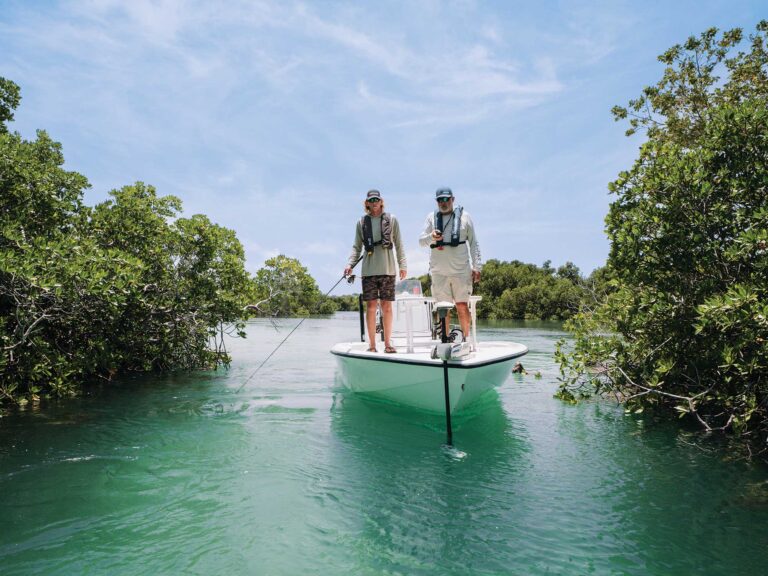The first full-size boat from Polaris was seen as a sketch, inevery sense of the word rough. It was drawn on the same palettefootball coaches use to dream up offensive plays: a paper napkin.In its original rendition, the boat looked to be over 20 feet longwith a wide beam, high curves in the gunwales and an aerodynamicstern. In its final form, the EX2100 Sport Boat doesn’t lookmuch different from that original draft, drawn with pen and paperat a restaurant table.
We drew our impressions of the new Polaris during a land checkand test drive of the first model out of the mold. First, we weresurprised at the boat’s size. As a builder of personalwatercraft, Polaris would be expected to follow the path of theother PWC makers that have grown the jet boat market. They start bycreating little fun machines before bulking up to recreationalboats. But Polaris skipped the “in-between” process andwent straight to a 21-foot sport boat with an open bow and a50-gallon fuel capacity.
“We have a new team in place,” says Ron Bills,general manager of Polaris Watercraft, “and our backgroundsare in the boat business, not just watercraft folks.”That’s why the EX2100 is all fiberglass, including thestringers and transom, with an 18-degree deadrise and channelsalong the keel, all of which come from the pleasure boat influence.For rigidity they’ve gone the route taken by top-shelfperformance boat companies like Baja and incorporated a half-inchof balsa core. They also carefully fit the stringers to run flushagainst the hull and bonded them in place with aircraft-qualityadhesives. The result is a solid boat rated for 250 horsepower.
Then there was the outer design of our intro boat. It’svery wide through the midsection, with dramatically rounded linesthrough the bow and around the windshield frame, capped by astylish raised transom and sun pad. Overall, the style cannot beconfused with any other jet-drive boats. Polaris chose to partnerwith Baja Marine in the development of the EX2100, so it carriesthe racy look for which Baja is known. Baja also brings aclosed-mold building process to the table, so the thickness oflaminates is more consistent than you’ll find in an open-moldboat.
Mercury makes up the third part of this development tripod. Theyoffered input not only for power but for a bottom design that wouldsupport maximum power without sacrificing safety.
Polaris didn’t skimp in places where they could have.Hinges, air intakes and grab handles are stainless steel. Cleatsare extra-large, Teleflex gauges are the size of salad dishes andgas shocks open and hold the transom-wide engine lid. The boatcomes standard with a CD player, sport wheel and matching trailer.(For boaters who regularly pull water sports we’d suggestopting for the extended pylon by Swivel-eze.)
Our test of this early edition was on a small lake in CentralFlorida, just long enough to find a legitimate top speed of 49.4mph (with 480 pounds of people and 30 gallons of fuel) under thepower of a 250-hp OptiMax jet drive. The bow tipped a little attakeoff but not enough to interrupt our forward sightlines.Dawdling in three feet of water did not elicit anxiety becausejet-powered boats have no exposed outdrive or prop to be damaged inshallow water. You just have to watch your draft; get shallowerthan that and you can draw sand or debris into the jets, harmingthe impeller.
It was in turns that the EX2100 made its mark. A Mercurytechnician challenged us to pin the throttle and the wheel. In mostother jet-drive boats that maneuver would cause us to immediatelyspin 360 degrees. But because the Polaris has a channel on eachside of the keel, the bottom surface stayed wet, and the boatturned sharply but under complete control. We couldn’t spinit out. In reverse, a bucket drops over the jets to preciselydirect water in such a way that the boat is easy to handle at slowdocking speeds.
A couple of points about our test boat: Its dry weight was 2,300pounds, but the design team was planning to lose some laminates tolighten production models by 300 pounds, which in theory will getan extra mph or two. Also, we were promised that the throttleposition would be moved away from the gunwale so knuckleswon’t bump the coaming pad.
We expect to hear more from Polaris in the runabout market. Ourdrive of this intro model was full of more positives than we hadanticipated from a longtime player in the watercraft market. Andusing EX as a prefix tells us they’ll have a sister model inthe near future.
POWER CURVE
RPM MPH
1,000 3.8
1,500 4.4
2,000 5.9
2,500 6.9
3,000 7.7
3,500 8.7
4,000 27.8
4,500 33.4
5,000 41.7
5,400 48.6
Time to Plane: 2.8 sec.
Time to 30 mph: 8.0 sec.
Noise at 30 mph: 83 db
Noise at idle: 74 db
Test Engine: Mercury 250-hp OptiMax jet drive
Test Load: People (480 lb.); Fuel (30 gal.)
MSRP: $23,999
Contact: 800-765-2747, polaris









